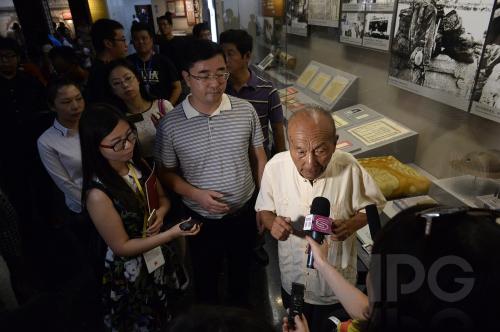| 
Reporters conduct an interview in the Museum of the War of Chinese People's Resistance Against Japanese Aggression in Beijing on August 29
Bright blue sky, a fleet of diplomats' cars outside, flocks of journalists inside, a memorial site in the size of a small town: right next to the Lugou Bridge - better known in the West as the Marco Polo Bridge - is the location of the Museum of the War of Chinese People's Resistance Against Japanese Aggression. Since these are the outskirts of the Beijing metropolis, the museum and the bridge are a little off the beaten track for tourists but are definitely worth a visit.
That very bridge was the scene of the Marco Polo Bridge Incident, which led to the escalation of the war of resistance, as it is called in China, to a full-scale war between China and Japan. By then Japan had already occupied northeast China, where a puppet state was installed. The incident at the Marco Polo Bridge happened on July 7, 1937 - Hitler-Germany's invasion of Poland, which marks the beginning of World War II (WWII) in Europe, took place more than two years later on September 1, 1939.
Due to our Western-centric view of the world, we sometimes forget the victims of the war in Asia and their sacrifices and contributions. In the face of long years of war and war crimes, which are beyond anything the human mind wants to perceive - among them genocide, massacres, disease and starvation - we Europeans tend to see WWII as an exclusively European story, missing the fact that the war in Asia started earlier than in Europe.
Entering the museum, the visitors immediately face larger-than-life, grimmer-than-life statues united for a war of resistance. Due to their sheer size, I usually find Chinese museums a bit intimidating; museums on wars generally scare me. The Museum of the War of Chinese People's Resistance Against Japanese Aggression combines these feelings and fills the visitor with respect.
In the war of resistance, the two parties, the Communist Party of China (CPC) and the Nationalist Party, or Kuomintang, fought together in a united front. The museum therefore tells a story of a united people who defended their country against Japanese invaders.
In China, the war is perceived as the first victory after centuries of humiliation at the hands of foreign powers, and the museum wants to tell a story about what a united nation can achieve. The museum therefore also shows the contribution of civil society and women. In addition, it gives a very vivid impression of how CPC leaders lived during the war. For example, we saw Mao Zedong in Yan'an and Zhou Enlai aging over the years.
A multimedia show, battlefield scenery to walk around, a multitude of historical materials: the museum displays wartime, ostensive and vivid. The museum's target audiences are school classes; however, it is interesting for foreign audiences, as it gives us the opportunity to question our views of history.
As this war was not only a Chinese-Japanese war but also an important scene of WWII, the museum values foreign contribution and support. One cannot imagine how WWII might have ended if the Soviet Union had had to defend their eastern border the same as the western. As it was, it could focus on the European theater.
After all these martial impressions of war, the beauty of the Marco Polo Bridge is overwhelming. The former crucial access point to Beijing is today closed for traffic. This architectural masterpiece, lined with cute stone lions, makes a picturesque historical site. And its beauty finally brings the mind some peace.
Visiting the museum inspired me to read more about WWII. We must never forget where the fascist ideology led to, with its black-and-white schemes, its vicious ideas of race, the crazy concept that one "race" is superior to another and the tremendous suffering it brought to the entire world. And we must not forget that peace may be the only path to historical justice.
(The author is an Austrian living in Beijing) |